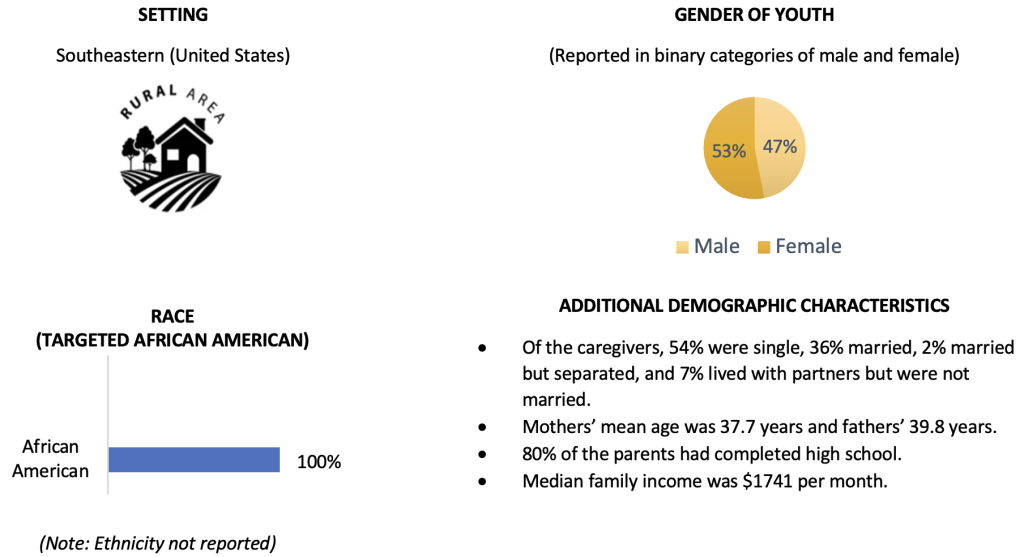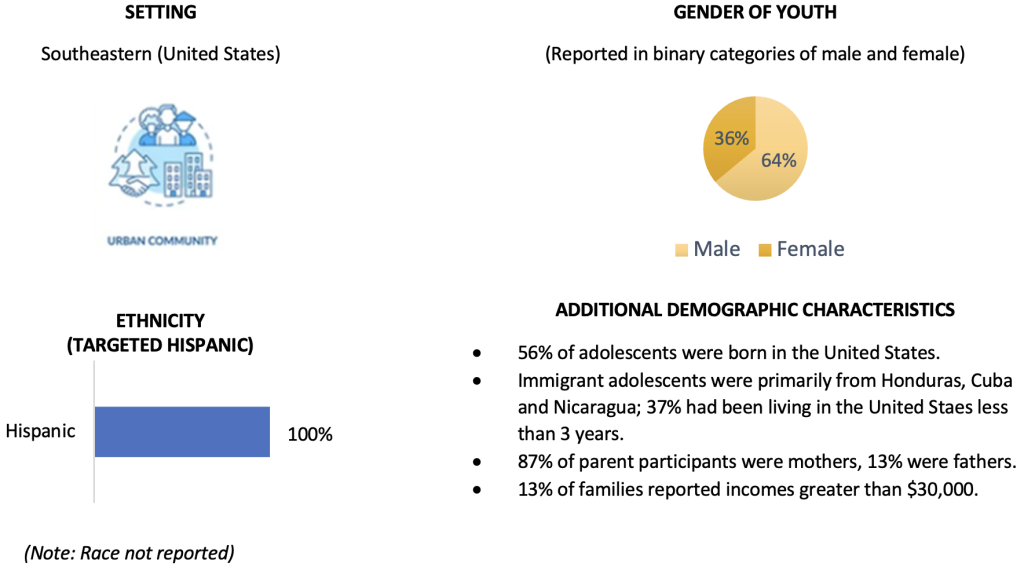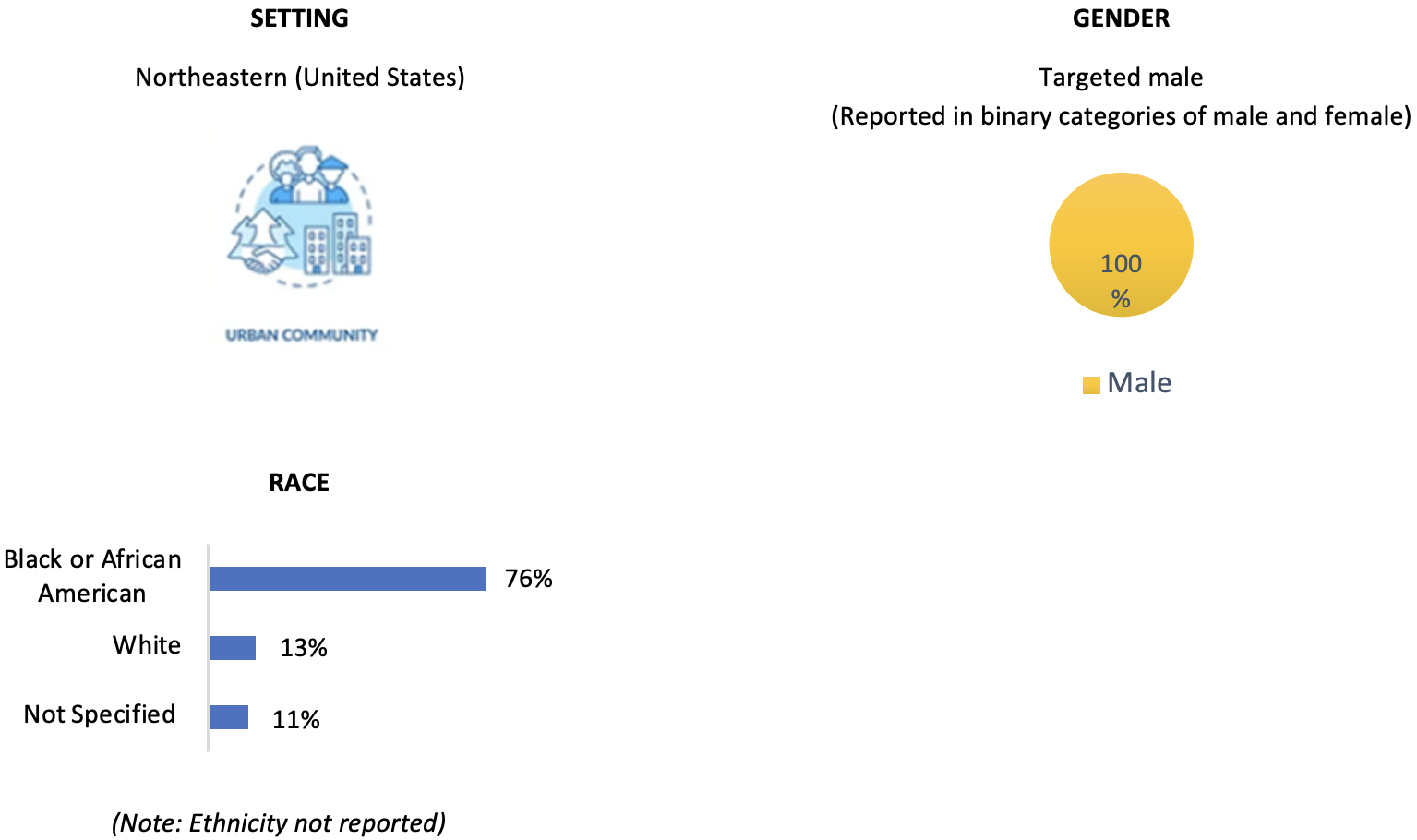
Program Description: Nurse-Family Partnership (NFP) is a home visitation program that provides first-time, primarily low-income mothers with guidance and support in developing effective childrearing practices with the goal of improving long-term outcomes for mother and child. Beginning as early as possible during pregnancy, NFP nurses initiate home visitations with pregnant women who are predisposed to infant health and developmental problems (preterm delivery and low-birthweight children). Visits last 60-90 minutes every other week and continue through the child’s second birthday.
Program content covered in the home visits includes (a) parent education about influences on fetal and infant development; (b) the involvement of family members and friends in the pregnancy, birth, early care of the child, and support of the mother; and (c) the linkage of family members with other formal health and human services. Specific objectives include improving women’s diets; helping women monitor their weight gain and eliminate the use of cigarettes, alcohol, and drugs; teaching parents to identify the signs of pregnancy complication; encouraging regular rest, appropriate exercise, and good personal hygiene related to obstetrical health; and preparing parents for labor, delivery, and early care of the newborn.
Results: Blueprints has certified three studies evaluating Nurse-Family Partnership, each with results spanning multiple years after the end of the intervention.
Study 1: The first study produced articles over a span of several decades (Eckenrode et al., 2000, 2001, 2010, 2017; Olds et al., 1986a, 1986b, 1988, 1994, 1995, 1997, 1998; Zielinski et al., 2009) and involved 400 women from private obstetric offices and a free antepartum clinic in the rural Appalachian region of New York State. Women were randomly assigned to 1) a treatment group receiving home visits during pregnancy, 2) a second treatment group receiving home visits up to 24 months after birth, or 3) a control group in which the child received sensory and developmental screening. Relative to women in the control group, nurse-visited women were significantly healthier – fewer hypertensive disorders and kidney infections, improved diet, reductions in cigarette use – during pregnancy and for two years after the child’s birth. Compared to children in the control group, children of nurse-visited mothers displayed improved emotional and cognitive development in early childhood, experienced fewer instances of child abuse and neglect through age 15, and had fewer arrests and convictions through age 19.
Characteristics of Study Sample as Reported by Study Authors:

Study 2: Olds et al. (2002, 2004, 2014) conducted a randomized controlled trial with 735 low-income pregnant women receiving antepartum care in Denver, Colorado. The women were randomly assigned to one of two treatment groups (received home visits from a nurse or a paraprofessional), or a control group that received developmental screening and referrals for the child. Relative to the control group, nurse-visited women exhibited lower levels of nicotine use during pregnancy, fewer and delayed subsequent pregnancies through the child’s second birthday, more months worked in the second year after birth, and less domestic violence through four years after birth. Additionally, the mother-child pairs showed greater levels of responsive interaction, and the children experienced less emotional vulnerability at six months of age compared to the control group.
Characteristics of Study Sample as Reported by Study Authors:

Study 3: Kitzman et al. (1997, 2000, 2010), Olds et al. (2004, 2007, 2010, 2014), Sidora-Arcoleo et al. (2010), Heckman et al. (2017), and Enoch et al. (2018) conducted a randomized controlled trial with 743 pregnant women in Memphis, Tennessee. Women were randomized to one of four groups: a high exposure treatment group, a low exposure treatment group, a usual care control group, or a slightly enhanced usual care control group offering developmental screening and referral services. All women in the nurse-visited treatment groups received intensive home visits during pregnancy, but the low exposure group received only two post-partum visits while the high exposure group continued receiving visits for 24 months after birth. Compared to women in the enhanced control group, women in the high exposure treatment group had better mental, physical, and reproductive health outcomes and more economically stable households for six years after birth. Over the first two years of life, children born to nurse-visited mothers had fewer injuries and hospitalizations compared to children of control group mothers. Program benefits of higher test scores and fewer behavior problems extended to age six for children of nurse-visited women. Maternal and child mortality rates were also significantly lower for nurse-visited mothers and their children through 20 years after birth.
Characteristics of Study Sample as Reported by Study Authors:

Cost-Benefits: In terms of cost-benefit analysis, Washington State Institute for Public Policy (December 2023) reports $1.47 in measured benefits per $1 spent in implementing Nurse-Family Partnership.
References:
Study 1
Eckenrode, J., Ganzel, B., Henderson Jr., C. R., Smith, E., Olds, D. L., Powers J., … Sidora, K. (2000). Preventing child abuse and neglect with a program of nurse home visitation: The limiting effects of domestic violence. JAMA, 284(11), 1385-91.
Eckenrode, J., Zielinski, D., Smith, E., Marcynyszyn, L. A., Henderson, C. R., Kitzman, H., … Olds, D. (2001). Child maltreatment and the early onset of problem behaviors: Can a program of nurse home visitation break the link? Development and Psychopathology, 13(4), 873-890.
Eckenrode, J., Campa, M., Luckey, D. W., Henderson, C. R., Cole, R., Kitzman, H., … Olds, D. (2010). Long-term effects of prenatal and infancy nurse home visitation on the life course of youths: 19-year follow-up of a randomized trial. Archives of Pediatrics & Adolescent Medicine, 164, 9-15.
Eckenrode, J., Campa, M. I., Morris, P. A., Henderson, C. R., Bolger, K. E., Kitzman, H., & Olds, D. L. (2017). The prevention of child maltreatment through the Nurse Family Partnership Program: Mediating effects in a long-term follow-up study. Child Maltreatment, 22(2), 92-99.
Olds, D. L., Henderson, C. R., Chamberlin, R., & Tatelbaum, R. (1986). Preventing child abuse and neglect: A randomized trial of nurse home visitation. Pediatrics, 78, 65-78.
Olds, D. L., Henderson, C. R., Tatelbaum, R., & Chamberlin, R. (1986). Improving the delivery of prenatal care and outcomes of pregnancy: A randomized trial of nurse home visitation. Pediatrics, 77, 16-28.
Olds, D. L., Henderson, C. R., Tatelbaum, R., & Chamberlin, R. (1988). Improving the life-course development of socially disadvantaged mothers: A randomized trial of Nurse Home Visitation. American Journal of Public Health, 78(11), 1436-1443.
Olds, D. L., Henderson, C. R., & Kitzman, H. (1994). Does prenatal and infancy nurse home visitation have enduring effects on qualities of parental caregiving and child health at 25 to 50 months? Pediatrics, 93, 89-98.
Olds, D. L., Henderson, C. R., Kitzman, H., & Cole, R. (1995). Effects of prenatal and infancy nurse home visitation on surveillance of child maltreatment. Pediatrics, 95(3), 365-372.
Olds, D. L., Eckenrode, J., Henderson, C. R., Kitzman, H., Powers, J., Cole, R., … Luckey, D. (1997). Long-term effects of home visitation on maternal life course and child abuse and neglect: 15-year follow-up of a randomized trial. Journal of the American Medical Association, 278(8), 637-643.
Olds, D. L., Henderson, C. R., Cole, R., Eckenrode, J., Kitzman, H., Luckey, D., … Powers, J. (1998). Long-term effects of nurse home visitation on children’s criminal and antisocial behavior: 15-year follow-up of a randomized controlled trial. Journal of the American Medical Association, 280(14), 1238-1244.
Zielinski, D. S., Eckenrode, J., & Olds, D. (2009). Nurse home visitation and the prevention of child maltreatment: Impact on the timing of official reports. Development and Psychopathology, 21, 441-453.
Study 2
Olds, D. L., Robinson, J., O’Brien, R., Luckey, D. W., Pettitt, L. M., Henderson, C. R., … Talmi, A. (2002). Home visiting by paraprofessionals and by nurses: A randomized, controlled trial. Pediatrics, 110, 486-496.
Olds, D. L., Robinson, J., Pettitt, L., Luckey, D. W., Holmberg, J., Ng, R. K., … Henderson Jr., C. R. (2004). Effects of home visits by paraprofessionals and by nurses: Age 4 follow-up results of a randomized trial. Pediatrics, 114, 1560-1568.
Olds, D. L., Holmberg, J. R., Donelan-McCall, N., Luckey, D. W., Knudtson, M. D., & Robinson, J. (2014). Effects of home visits by paraprofessionals and by nurses on children follow-up of a randomized trial at ages 6 and 9 years. JAMA Pediatrics, 168(2), 114-121.
Study 3
Enoch, M. A., Kitzman, H., Smith, J. A., Anson, E., Hodgkinson, C. A., Goldman, D., & Olds, D. L. (2018). A prospective cohort study of influences on externalizing behaviors across childhood: Results from a nurse home visiting randomized controlled trial. Journal of the American Academy of Child & Adolescent Psychiatry, 55(5), 376-382.
Heckman, J. J., Holland, M. L., Makino, K. K., Pinto, R., & Rosales-Rueda, M. (2017). An analysis of the Memphis Nurse-Family Partnership program. Cambridge, Massachusetts: National Bureau of Economic Research.
Kitzman, H., Olds, D. L., Henderson, C. R., Hanks, C., Cole, R., Tatelbaum, R., … Barnard, K. (1997). Effect of prenatal and infancy home visitation by nurses on pregnancy outcomes, childhood injuries, and repeated childbearing. Journal of the American Medical Association, 278(8), 644-652.
Kitzman, H., Olds, D. L., Sidora, K., Henderson Jr., C. R., Hanks, C., Cole, R., … Glazner, J. (2000). Enduring effects of nurse home visitation on maternal life course: A three-year follow-up of a randomized trial. Journal of the American Medical Association, 283(15), 1983-1989.
Kitzman, H., Olds, D. L., Cole, R. E., Hanks, C. A., Anson, E. A., Arcoleo, K. J., … Holmberg, J. R. (2010). Enduring effects of prenatal and infancy home visiting by nurses on children: Follow-up of a randomized trial among children at age 12 years. Archives of Pediatrics & Adolescent Medicine, 164(5), 412-418.
Olds, D. L., Kitzman, H., Cole, R., Robinson, J., Sidora, K., Luckey, D. W., … Holmberg, J. (2004). Effects of nurse home visiting on maternal life course and child development: Age 6 follow-up results of a randomized trial. Pediatrics, 114, 1550-1559.
Olds, D. L., Kitzman, H., Hanks, C., Cole, R., Anson, E., Sidora-Arcoleo, K., … Bondy, J. (2007). Effects of nurse home visiting on maternal and child functioning: Age 9 follow-up of a randomized trial. Pediatrics, 120, 832-845.
Olds, D. L., Kitzman, H., Cole, R., Hanks, C., Arcoleo, K., Anson, E., … Stevenson, A. (2010). Enduring effects of prenatal and infancy home visiting by nurses on maternal life course and government spending: Follow-up of a randomized trial among children at age 12 years. Archives of Pediatrics & Adolescent Medicine, 164(5), 419-424.
Olds, D. L., Kitzman, H., Knudtson, M. D., Anson, E., Smith, J. A., & Cole, R. (2014). Effect of home visiting by nurses on maternal and child mortality: Results of a 2-decade follow-up of a randomized clinical trial. JAMA Pediatrics, 168(9), 800-806.
Sidora-Arcoleo, K. H., Anson, E. A., Lorber, M., Cole, R. E., Olds, D. L., & Kitzman, H. J. (2010). Differential effects of a Nurse Home-Visiting Intervention on physically aggressive behavior in children. Journal of Pediatric Nursing, 25, 35-45.
Read the Program Fact Sheet














